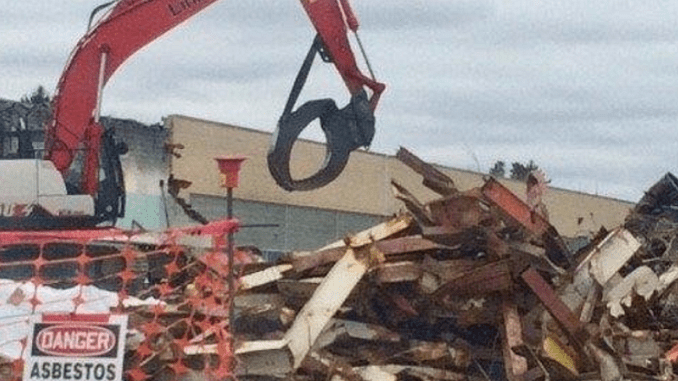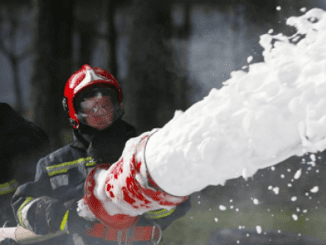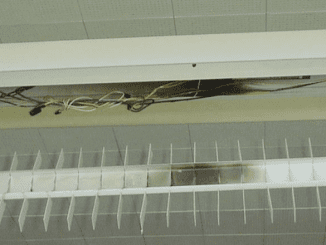
BINGHAMTON, New York, December 2, 2021 (ENS) – Two convicted asbestos criminals will be jailed and fined nearly $400,000 for exposing their workers and the surrounding community to the risk of diseases caused by asbestos exposure – lung cancer, asbestosis, and mesothelioma, an invariably fatal disease.
For conspiring to violate Clean Air Act regulations that control the safe removal, handling and disposal of asbestos, U.S. District Judge Thomas McAvoy sentenced Kristofer Landell and Stephanie Laskin to eight months and 10 months of incarceration, respectively, as well as three years of supervised release, and the surrender of asbestos-related licenses.
Co-defendants Roger Osterhoudt, Gunay Yakup and Madeline Alonge were all sentenced to three years’ probation in early November.
All five defendants were ordered to pay $399,000 in restitution to the U.S. Environmental Protection Agency, EPA, for its costs to clean up the now-contaminated site in Ulster, New York known as the Tech City property.
In his plea agreement, Osterhoudt, the vice president of property management for TechCity, admitted that as a result of the defendants’ illegal asbestos removal, there likely was a release of asbestos into the environment that placed others at an increased risk of death or serious bodily injury.
A naturally occurring mineral composed of sharp, flexible fibers that resist heat, electricity, and corrosion, asbestos has been determined to cause lung cancer, asbestosis, and mesothelioma, an invariably fatal disease.
According to documents filed in court, Landell, Laskin, Yakup, and Alonge engaged in a year-long conspiracy to violate federal and New York State Department of Labor, NYSDOL, regulations intended to prevent human exposure to asbestos.
The contaminated property in the town of Ulster was originally developed by IBM. It became a 2.5 million-square-foot IBM factory, testing center and office complex that was closed by IBM in the early 1990s as part of the company’s cost cutting program.
The site was maintained in good condition by the company and was redeveloped as Tech City, a venture that rented the space to users of 50,000 to 500,000 square feet, including IBM.
Between 2015 and 2016, Landell and Laskin both permitted, and in some cases directed, abatement workers to remove asbestos from the TechCity property illegally by stripping regulated materials containing asbestos without properly containing the work area. They also removed the asbestos dry, allowing airborne asbestos fibers to escape into the surrounding environment.
In an effort to conceal those crimes, Landell, acting in his capacity as an air and project monitor, concealed these violations by fabricating and falsifying paperwork required by EPA and the State of New York.
Despite the defendants’ efforts to conceal their crimes, NYSDOL inspectors found numerous violations during the course of the year-long project and issued notices of violation.
Conditions at the TechCity Property deteriorated until NYSDOL shut down operations in August 2016 and directed the defendants and their companies to cease all work. Notwithstanding this NYSDOL order, the defendants continued operations, prompting a criminal investigation.
Given that EPA has determined that there is no safe level of exposure to asbestos, the United States has endeavored to identify all those persons in close proximity to the illegal asbestos operations during the TechCity project and is seeking restitution on behalf of all those potentially exposed to airborne asbestos contamination during the relevant time period.
That process is ongoing, and the defendants may be ordered to pay additional money to members of the community who were potentially exposed to hazardous air pollutants as a result of the conspiracy.
Special agents of the EPA investigated the case with the assistance of New York State Department of Environmental Conservation and with information provided by the NYSDOL Asbestos Control Bureau and the federal Occupational Safety and Health Administration.
Featured image: The U.S. Environmental Protection Agency removed and disposed of 200 tons of asbestos-contaminated material and decontaminated 150 tons of steel, which was shipped off the TechCity site for recycling. 2019-2020 (Photo courtesy U.S. EPA)
© 2021, Environment News Service. All rights reserved. Content may be quoted only with proper attribution and a direct link to the original article. Full reproduction is prohibited.



